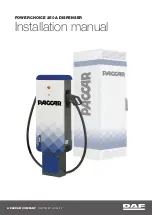
4
disconnected before connecting the input power to the terminals
of the charger.
4.3.3.
To the mains supply: You may only connect to the 1-phase 230Vac
or 3-phase 400Vac mains supply (depending on the type of the
charger) by means of a standard socket and an appropriate circuit
breaker (not supplied). The current consumption is shown on the
charger’s information plate.
4.3.4.
Connection to battery: The charger must be connected to the battery
by the cables supplied:
- The RED cable: to the battery’s POSITIVE terminal.
- The BLACK cable: to the battery’s NEGATIVE terminal.
4.4. AC circuit protection
4.4.1.
The user must provide suitable branch circuit protection and a
disconnect method from the AC power supply to the charger to
allow for safe servicing
4.4.2. CAUTION: Risk of Fire/Electrick shock. Use only on circuits
provided with branch circuit protection in accordance with laws
and standards.
4.4.3. The prevailing safety regulations must be observed. The system
protection installed on the power supply to the charger must
conform to the charger’s electrical characteristics. The installation of
a suitable circuit breaker is recommended. It is imperative to ensure
that when fuses are being replaced only fuses of the specified type
and of the correct are used.
4.4.4. This equipment conforms to Class 1 safety standards, which means
that the appliance must be earthed and requires to be powered
from an earthed supply.
4.5. Grounding the charger
4.5.1. Grounding the charger
4.5.2.
Connect ground wire to the proper terminal
usually marked with either of the two symbols to the right.
4.5.3. DANGER: FAILURE TO GROUND THE CHARGER COULD LEAD TO
FATAL ELECTRIC SHOCK. Follow National Electric Code for ground
wire sizing.
4.6. DC connector polarity
4.6.1.
DC plug polarity
4.6.2.
The charging cables are connected to the DC output of the charger:
the red charging cable (POS) is connected to the positive busbar of
the charger, and the black charging cable (NEG) is connected to the
negative busbar of the charger. The output polarity of the charger
must be observed when connecting to the battery. Improper
connection will open the DC fuses in the power modules.
4.7. EU Declaration
EnerSys® hereby declares that the chargers in the IMPAQ™charger ranges are
in conformity with the following UK and European regulations:
•
Electrical Equipment (Safety) Regulations 2016 (S.I. 2016/1101)
•
European Directive 2014/35/EU
Safety
BS EN IEC 62368-1 : 2020 + A11 :2020
•
EMC Regulations 2016 (S.I. 2016/1091)
•
Directive 2014/30/EU:
Electromagnetic Compatibility
BS EN IEC 61000-6-2: 2019
BS EN IEC 61000-6-4: 2019
•
Directive 2011/65/EU
RoHS
•
Control of Electromagnetic Fields Regulations (S.I. 2016/588)
•
Directive 2013/35/EU:
Electromagnetic fields
BS EN IEC 62311: 2020
Note: DC cables of the charger emit low power magnetic fields in their
surroundings (<5cm). Even if emissions are below the standard limits,
people bearing medical implants should avoid operating close to the
charger during recharge.
5. Operating Instructions
Reference
Function
Description
1
LCD Display
Display charger operation info/menus
2
Navigate UP button
Navigate menus / Change values
3
ENTER/STOP
and START button
Select menu items / Enter values /
Stop and restart battery charge
4
Navigate RIGHT/
EQUALIZE button
Scroll right / Start equalize or desulfation
5
Navigate
DOWN button
Navigate menus / Change values
6
Navigate
LEFT/ ESC button
Enter main menu / Scroll left / Exit menus
7
RED fault indicator
OFF = no fault
FLASHING = ongoing fault detected
ON = fault
8
YELLOW
charging indicator
OFF = charger off or battery not available
ON = charging in progress
9
GREEN charge
complete indicator
OFF = charger off or battery not available
FLASHING = cooling phase
ON = battery ready and available
10
BLUE AC
supply indicator
OFF = AC missing
ON = AC present
11
USB port
Download memos / Upload software
4. Installation (cont.)
5.1.
Control panel features (cont.)
5.1.
Control panel features
5.3.2. Displaying a Charge Cycle
Proceed as follows:
1. Select a record (MEMO x) using the buttons.
2. Display the first History screen by pressing Enter.
3. Display the second History screen by pressing .
4. Return to the Main Menu by pressing Esc.
The charge history is displayed; use the to scroll through the
parameters.
5.3.3. Memorization Data
5.2.
Menu access
When the charger is idle, press and hold <ESC>, the Main Menu is then
displayed. The main menu is automatically exited after 60 seconds of
inactivity or can be exited voluntarily by pressing the <ESC> button.
5.2.1. Main Menu
All menus are accessed from Main Menu; a detailed description of each
menu is included in the next sections of this manual. The menus that
require a password are not displayed until the correct password has been
entered.
The menus provide access to the following functions:
•
View last 200 charging cycles (Memo menu).
•
View of faults, alarms, etc. (Status menu).
•
USB functions (USB menu).
•
Setting of date, language and others (Parameters menu).
•
Management of password (Password menu)
5.3.
MEMORIZATIONS
5.3.1. Memorizations Display Screen
The charger can display the details of the last 200 charge cycles.
The display below shows one charge stored in memory. MEMO 1 is the
latest charge memorized. After memorizing the two-hundredth charge,
the oldest record is deleted and replaced by the next oldest.
Memo
Description
Profile
Selected profile
Capacity
Rated battery capacity (AH)
U batt
Rated battery voltage (V)
Temp
Battery temperature at start of
change (F)
% init
Battery voltage at start of charge
(%)
U start
Battery voltage at start of charge
(Vpc)
U end
Battery voltage at end of charge
(Vpc)
I end
Current at end of charge
Memo
Description
Chg Time
Time of the change
cycle (minutes)
AH
Amp-hours returned
during charge cycle
SoC
Start of charge
date and time
DBa
Battery disconnect
date and time
Status
Partial or complete
Fault
Fault Codes
CFC
Termination code
(for service tech)
























